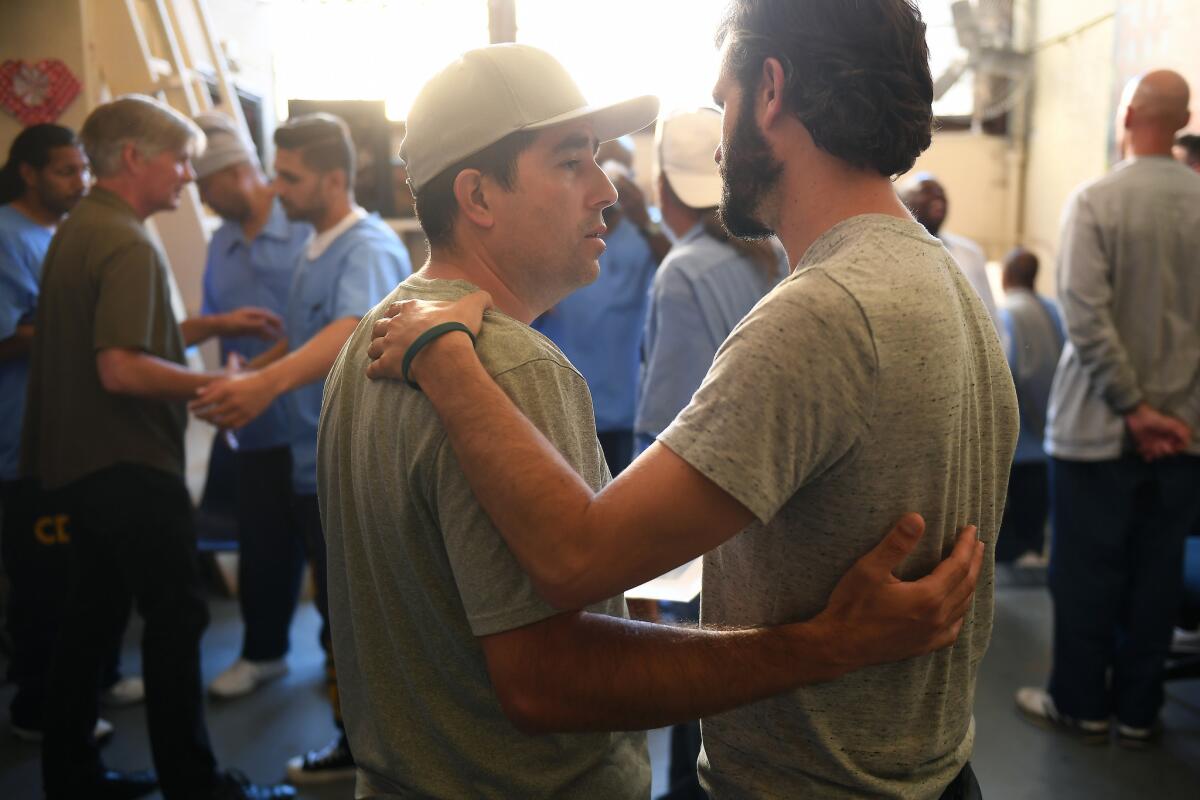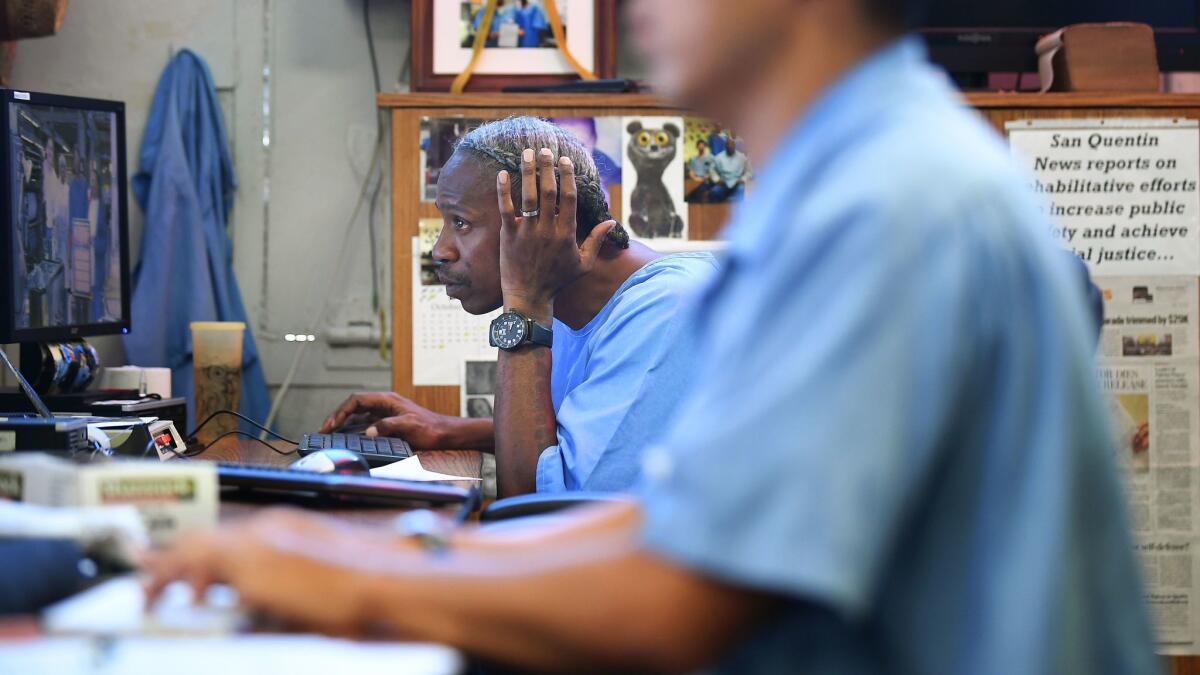A prison newsroom mourns its former editor in chief, recently released and then killed in a crash

- Share via

Down past the prison yard, where blue lilies grow near a fence topped with barbed wire, the men who manage one of the nation's only inmate-run newspapers were mourning.
The front page of their next edition would mark the death of Arnulfo Garcia, who had been their editor in chief — and so much more.
Garcia had come to San Quentin State Prison as a heroin addict and burglar. He had transformed himself over more than 16 years into a beloved leader and living, breathing symbol of hope and redemption.
At the prison, they called him jefe because he ran the San Quentin News. They called him pachuco because in his youth he used to walk with such swagger. They loved his dry chili peppers, which he carried in his pocket and passed out to them like candy.
And they felt such hope for him when he walked out to freedom in July, full of big plans for not just his but their future.
He was deep into those plans two months after his release when he got in a car with his sister. She was driving. They were in a crash. Both were killed.
Garcia was a three-striker whose sentence was cut for good behavior from 65 years to 16. He used to tell men serving decades for robberies, assaults and murders to focus not on getting out of the infamous penitentiary but on becoming better men — men who moved forward and thought big.
"It takes a team to make it to the moon,” he used to say.
And they had faith in his goals, no matter how grandiose — to reform the criminal justice system, to end gang violence, to turn a fledgling newspaper into an award-winning publication.
Out in the yard, prisoners divide by color — blacks with blacks, whites with whites — but in the old laundry room turned newsroom, Garcia led a mix of men whose sole focus was telling stories and putting out the paper.
That work continued on a recent afternoon.
Jesse Vasquez, a staff writer serving 30 years to life for attempted murder, placed a thermos with Garcia’s favorite tea out on the pavement near the newsroom’s front door to ferment in the hot sun, the way Garcia taught him. Jonathan Chiu, in for first-degree murder, pieced together the paper’s crossword puzzle. And Richard Richardson, long and lanky like Snoop Dogg, bent over his computer pushing himself to finish his toughest assignment yet: Garcia’s obituary.
Richardson, who goes by Bonaru, serving time for home robbery, took over as editor after Garcia left. The two were best friends, he said.
“He taught me how to be a man, how to be a father, to be responsible and accountable for my actions.”
‘Drop that monkey off your back’
Garcia, who was 65 when he died, was in and out of jail for nearly 50 years.
He spent part of his childhood picking prunes on a farm in Northern California and as he grew up became a heroin addict. When he was busted for home robbery in the 1990s and faced 123 years in prison, he skipped bail and fled to Mexico.
His mother pleaded with him. Quit drugs, have a child, settle down.
“Drop that monkey off your back,” Carmen Garcia told him. “Then I can die in peace.”
Garcia did what his mother asked in the countryside of Mexico, working on a farm, staying clean. He met someone, and they had a daughter and named her Carmen.
But eventually his past caught up with him. He was arrested and sent to San Quentin.
In his 6-by-10 cell, he started writing. He told his life story and the stories of other inmates expelled from society because they killed their wives, shot up gang rivals, robbed gas stations, peddled drugs.
Garcia wrote thousands of words — now scattered in notebooks, on flash drives and pieces of toilet paper.

“He was a listener, someone you could talk to about your secrets and your sadness and the harm that you’ve done to others,” said his brother Nick, who also served time at San Quentin.
For years, Garcia had brushed aside his mistakes. “I blamed my father, the police, the probation office, the D.A., the judges,” he wrote in a 2014 column. “I blamed everyone but myself.”
Writing, he said, brought a new kind of clarity. “I came full circle to the realization that the person responsible for my situation was me.”
When he and Richardson began working in the prison’s print shop, Garcia didn’t even know how to turn on a computer. But they used to listen to the chatter of reporters and editors nearby in the newsroom.
“They’d be arguing about what story to run on the front page,” Richardson said. “And we’d get in there and tell them our opinion.”
The prison newspaper was just revving up again then. A prison warden had brought it back to life, after more than 20 years. It ran on donations, as it does now, and the help of journalists on the outside.
Garcia was hired on as a writer in 2009 and began spending more and more time there. Two years later, he was editor in chief.
He saw in the San Quentin News an opportunity not just to give prisoners a voice but to educate them about prison programs they could use to improve themselves. He published stories about inmates doing yoga, putting on Shakespeare plays, getting paroled after participating in rehab programs, showing remorse for their crimes.
He once wrote about how three inmates saved a correctional officer as he choked on a piece of steak.
Garcia’s paper featured soul-searching profiles and editorials critical of budget cuts and prison conditions. He invited in district attorneys and judges, for forums to update them on life at the prison.
Bob Ayers, the warden who brought back the newspaper, said Garcia didn't just want a publication that squashed prison gossip. He wanted to do serious, respected journalism.
“While I may have plugged in the lamp, which was the resurrected San Quentin News,” he said. “Arnulfo tweaked it until it became a beacon."
Garcia did so under strict supervision. The newsroom had no internet access. Each story was carefully vetted.
By the time he left prison, the San Quentin News was printing 28,000 copies, distributed to 35 prisons run by the California Department of Corrections and Rehabilitation.
“Wall City,” the quarterly magazine he dreamed up, was nearly a reality. The first volume, full of inmates’ stories, was just about to go to press.
A brave new vision
The morning of the crash, Nick Garcia, who had also been paroled, spoke to his brother on the phone.
Arnulfo was at a gas station in Hollister. He sounded excited.
His biggest plan was to build a reentry home with a full treatment center, somewhere in the countryside, a place where newly freed prisoners could acclimate themselves to life outside the walls.
He had the support of officials at public safety agencies, social workers and several prosecutors, including those who had once locked him up. His family planned to help him pay for it.
He and his sister Yolanda were on their way to check out a possible property.
The crash occurred minutes after the brothers hung up. Police say Yolanda Garcia missed a stop sign. Her car was hit first by an SUV, then by a big rig.
Brother and sister died at the scene.
‘This one’s hard to take’

At San Quentin, a weekly support group helps prisoners manage their day-to-day anger.
Garcia once led the group. Now those who came were grief-stricken.
In a high-ceiling room that was nonetheless airless, they sat in a circle and took turns saying goodbye.
“Arnulfo, you pulled one on us, man,” said one inmate, his face slick with tears. “This one’s hard to take.”
“Many times I wanted to quit,” said another, staring at the floor. “You told me, ‘Come on, let’s go’”
“I appreciate you,” said Fateen Jackson, 41, “because you saw value in me.”
Lucia de la Fuente, one of the group’s coordinators, told the inmates that Garcia had squeezed every last bit of his two months of freedom. Barbecues, shopping trips with his daughter. Food — lots of great food.
De la Fuente said it made him so happy, he texted her photos of his beans, his scrambled eggs and Mexican sausage.
“He was abundant in every single way,” de la Fuente said.
She got her final text from him three days before the crash, she said.
He was coming over the Bay Bridge at sundown.
The light, he told her, was so beautiful.
esmeralda.bermudez@latimes.com
Times staff reporter Chris Megerian contributed to this story.
Sign up for Essential California
The most important California stories and recommendations in your inbox every morning.
You may occasionally receive promotional content from the Los Angeles Times.







